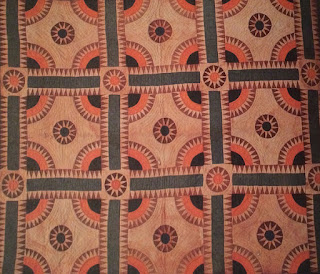 |
| This New York Beauty heirloom quilt was made in the 1860s and is featured on Page 60 of the book Florida Quilts. |
I'm fresh from a visit to the American Quilter's Society Daytona Beach Quilt Week. I saw beautiful examples of fiber arts - both traditional piecework and art quilts - got inspired, and also got thinking about the threads of continuity that bind quilters.
The fiber arts today are a hobby for most enthusiasts and a career for some. I'm an experienced seamstress but a novice quilter, with one quilt, one star-themed block for the NASA quilt, and one table runner to my credit. (2022 update: I've reached intermediate quilt status, with several more done since I first wrote this post!)
For women on the Florida frontier, quiltmaking was a necessity. Homemakers crafted bedcovers for family members and young women stitched quilts for their trousseaus. One such person was Sarah Asberry Brown Anderson.
Sarah's story is told in the 1992 book Florida Quilts, by Charlotte Allen Williams (University Press of Florida). Sarah lived in Wakulla County in North Florida when she started making the New York Beauty quilt pictured with this blog post. She was 12, and she dyed her homespun cotton fabric with tree bark solutions before cutting the pieces and hand-sewing the quilt. Sarah began the quilt in 1865 and finished it in 1869.
Williams writes that New York Beauty was a popular pattern in the late 1800s. Other designs popular in the late 19th century included:
- Friendship quilts that included embroidered signatures
- Log Cabin
- Irish Chain
- Album block quilts
- Crazy quilts
- Applique quilts that featured stylized flower designs
Sarah's descendants reported that she was proud of her New York Beauty quilt and preserved it through the years. One look at the photo and the level of craftsmanship is obvious. I'd be proud, too, if I'd cut and sewn together those hundreds of pieces into a beautiful finished whole. Having experimented with natural dyes, I can also attest to the quality of the fabric's colors.
The care given the New York Beauty is why it survived long enough to be documented in Florida Quilts. The book profiles some of the women and quilts uncovered during the Florida Quilt Heritage Project. That project, which I've written about before, did a remarkable job of bringing many women's lost stories back to life through their quilts.
Today, quiltmakers receive their just due and are credited for their work. The fiber arts are celebrated. This post is to pay homage to all the unsung needlewomen of the past.
View the Florida Quilt Project digital collection at The Quilt Index website. The Quilt Index is an open access digital repository.

